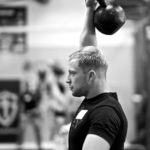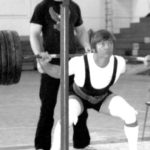Over 200 years ago, Swedish scientist Jöns Berzelius discovered lactic acid in the muscles of an exhausted stag that had just been hunted down.

Acid is the enemy of both tension and relaxation, drawing one into the stiff no-man’s land in between. It muffles the brain’s commands to the muscles, inhibits all three energy systems, and interferes with contraction and relaxation—read: strength and speed—in many ways.
As your speed goes down, you are moving to the right on the quick–dead continuum.
Max Dedik, Kyokushin karate champion and accomplished coach, is an enemy of metcons for fighters: “I often see prescriptions like 50 or 100 burpees in one or two sets. Go ahead, do it, but you will definitely lose speed.”
Dedik suggests comparing the speed exhibited during tournaments in full contact styles, like his own, and noncontact ones. “Point fighters avoid significant acidosis in training, as they know it ruins speed. And speed is their end-all…Compare the speed of their champions and ours. Any questions?”
Both speed and strength take a dive in acid, but power suffers the most. In fatigued muscles, speed and strength decrease by a similar percentage. This compounds the power drop-off, since power is an offspring of both. For instance, if the force and the velocity each go down by 20 percent, the power will tank by 40 percent. Feel free to add an exclamation mark.

When your bursts of effort are too long or if your rests are too brief—as in HIIT or metcons—power goes down. Way down. For instance, by the end of an all-out 30-second bicycle sprint, power drops by up to 50 percent.
Contemplate that: In just half a minute, acid cuts your power in half.
No longer able to contract quickly and powerfully, fatigued muscles compensate with longer and weaker contractions. This messes up movement coordination. It could mean failing to catch dinner—or becoming dinner yourself. Even if you have avoided such a fate, you are learning slowness and poor form for the next time.
Accustomed to always pushing through a sticky mud of muscle congestion, an athlete develops a particular movement stereotype. His allegedly explosive movements are anything but—as exemplified by burpees in metcon gyms. Sensei Dedik has seen it time and again: Fighters who abuse metcons lose speed and sharpness in their strikes. Instead of practicing to be quick, they are practicing to be dead.
Even if you survived your HIIT session today, you might become dinner tomorrow or the day after, drained of energy and crippled by soreness.
Old-school coaches knew what they were talking about: Lactic acid makes you sore. Today’s consensus is it is the fault of the microtrauma caused by eccentric contractions. Without questioning the latter, I insist that the former is just as guilty.
Conduct an experiment. Leaf through your training log and find some less-than-brilliant workout that made you very sore. Say, you did as many pushups as you could, rested for a minute, did it again, and then a third time. Recall how your shoulders and triceps felt for days.
Now, match the number of pushups, using the identical technique—but spread them throughout the day into sets of five reps done every 15 minutes.
After a couple of days of feeling great, you will never roll your eyes at an old-timer with a whistle and a stopwatch telling you that lactic acid makes you sore.
The acid does not literally burn holes through your muscles—but it triggers various processes that do.
Within your muscles are tiny bubbles, lysosomes, containing enzymes that dismantle and dispose of the components that are damaged or no longer needed. Lysosomes operate exclusively in an acidic environment. When acidity is moderate, they do what they are supposed to do, and even help muscles grow. But when the “burn” is out of control, lysosomes go on a destructive rampage that you feel a day or two after.
Although some lactic acid is needed to promote muscle hypertrophy through several mechanisms that are outside the scope of Q&D, its excess is destructive. Russians did a study to evaluate the anabolic and catabolic effects of different types of exercises and loads. Among those tested was a typical HIIT workout, 3×60 seconds on a veloergometer with two-minute rests. It was the most catabolic of all types of exercise; the anabolic phase was not reached even on day four.
To put things into perspective, another one of the tested loads was 10 sets of 20 frog jumps. This was also very catabolic—but less than the one before, in spite of the severe eccentric loading! And the anabolic phase finally did kick in after two or three days. These results are even more striking once we learn that the subjects were speedskaters—athletes accustomed to metcons, but not to eccentric loading.
Leave metcons, exhaustion, stiffness, and soreness to prey. Stay fresh to hunt another day.

Peter Park, strength and conditioning coach of JJ Muno (deadlifting above) Giancarlo Stanton, Lance Armstrong, Justin Verlander, Ken Roczen, Diana Taurasi, and other high-level athletes:
“I train the entire spectrum of the population, ranging from professional baseball and football players, motocross riders, cyclists, triathletes, golfers to high-end CEOs and high school athletes. I have not only seen incredible “what the hell” results with Pavel’s Quick and the Dead, everyone I work with reports better energy, great recovery, and improved body composition. In this book, Pavel reveals a minimalist program that will benefit any human.”






Hi Pavel, thanks so much for this book. I’m about the join the Fire Service in the UK. Would you say that the Quick and the Dead is a good program to follow for having powerful endurance in that line of work? Any reply is much appreciated, thanks for your time. Your books have taught me so much.
Pavel, thank you for generously sharing your wisdom. I recently listened to your Joe Rogan podcast and loved every minute. Back in April of this year I overtrained my legs with squats and HIIT and felt muscle soreness for well over a month. I then developed a UTI and then more serious male health issues that continued for six months. I am wondering if these problems could in fact be caused by excess levels of acid in my muscles. I just recently returned to the gym but I’m still worried about aggravating my issues. Any insight you can share is greatly appreciated. If you could help me I would also be interested in consulting. Thanks much
Pavel, Great Book
I’ve been on Q&D for 8 weeks and I feel big improvements in power and speed. My question is I’ll be taking a Bruce Protocol maximal stress test late November 2019 and I’m wondering if Q&D will prepare me for such a test?
Great to hear, Dave! Please post a review on Amazon:
https://www.amazon.com/Quick-Dead-Training-Advanced-Minimalist/dp/0989892425/ref=tmm_pap_swatch_0?_encoding=UTF8&qid=&sr=
Q&D will help you with this test—but not prepare for it. There is not much time left. For the next month build up your volume of aerobic work at MAF; the last few weeks before the test peak with progressively more acid and higher HR. Keep doing Q&D throughout.
Pavel
Thank you for your quick reply.
Just confirming MAF for a 57 year old would put me at 113 bpm. Right now I do Q&D on MWF and I feel powerful and energized. To maintain these qualities I’m open to suggestions to do MAF and Q&D simultaneously. Should I do the MAF right after Q&D or do them on my off days TRS?
I assume swings and push ups are not good choices for MAF since I’m already doing them on MWF?
Would jumping rope and/or Leopard crawling be better choices when I do MAF?
Logistically, running or walking is not an option.
I’m open to any suggestions you have to work both of these programs in during the week.
Thank You Kindly,
Dave
Dave, do MAF training with the modality you will be tested on (treadmill, bike).
You need to be fresh for Q&D, so separate the MAF sessions accordingly. E.g., Q&D Monday AM, MAF Monday PM.
Panel
Thank you for the useful information
Great article, Pavel. I’ve never done HIIT training in the past because intuitively it felt destructive. Nice to see science back it up.
I’m 41yrs old, 5’ 11” @ 220lbs and I’m currently doing S&S daily with the goal to reach the simple goal again (I want to own it this time). I never had issues with the TGUs (worked up to 10×1 @ 40kg previously) but my swings always trailed behind. In the past I’ve “completed” 10 sets of 1H swings @ 32kg in under 5min but it left me panting.
I’m restarting S&S with the 24kg in order to focus on technique and hopefully build up an aerobic base. However after 10 reps of 2H swings, I still feel it takes a while to pass the talk test. It’s taking me like 15min to get through a normal practice session.
Some have recommended to do 20 sets of 5 versus 10 sets of 10. And this seems to align well with your article.
Should I just continue doing S&S as prescribed and expect my conditioning to eventually improve or do you feel there is a benefit to doing sets of 5 instead?
Thanks again Pavel!
Leonardo, thank you for your kind words!
Sets of 5 (classic A+A) are less acidic than 10s but you will miss out on the muscle building benefits 10s. Feel free to do 20×5 as a progression step towards 10×10.
Thanks Pavel! I really appreciate the input.
Dear Pavel, does this mean that for “classic A+A” work you would nowadays recommend sets of 5 as Al Ciampa does?
I am asking because in QnD you reference the A+A articles on this homepage (as an option after QnD) and these plans are usually to be done with sets of 10, even on the minute. However, respected forum members recommend sets of 5 for those plans.
Bauer, 5 reps are the classic A+A. After ~8sec glycolysis takes over from the CP mechanism as the dominant energy system and one of original studies by Verkhoshansky used 8sec sprints.
10 rep sets come with a lot of WTHE but classifying them is a little challenging.
Firstly, I must say thank you for the book, I love what it is trying to achieve. I did wonder, however, how this protocol fits in with shorter endurance sports which tread the line of aerobic/anaerobic, such as rowing. Is it appropriate to support this sort of training and how might one fit it into a program which by its nature involves both aerobic and lactate inducing workouts?
Peter, Q&D can fit into training for almost any sport, including rowing, but since your body can handle only so much, you would be better off complimenting your rowing with Prof. Selouyanov’s slow fiber hypertrophy work that is described in a series of my blogs.
Another effective method for rowing is a type of A+A: rowing against 60-70% 1RM resistance at a low tempo (8-10 reps per minute).